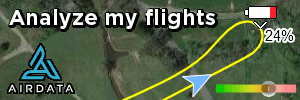R Martin
Well-Known Member
I think many people are raising concerns about what big brother will do in the future. I've been involved in aviation for many years, I have seen many changes. What I have seen is the FAA moves like molasses in the winter time. They seem to be more reactive than proactive at times. They are looking at how to safely allow drones to fly much greater distances meaning another headache for ATC. We can't have drones flying long distances without having a way for ATC to keep traffic separation. If anything we will eventually need a transponder and file actual flight plans with ATC, personally I think that is a long ways off, but with the speed that technology changes today it may be much sooner.
If this were about safety, then wouldn't the transmitted information go directly to ATC at a minimum in real time to be actionable? As proposed, this is rubbish as far as safety is concerned. All they are doing is putting on a digital license plate with a transmitter to both your aircraft and your base station/controller. ATC is out of the loop completely in a worst case scenario or receiving second or third hand information in a best case scenario. This NPRM as proposed makes no contribution to safety other than to identify the UAS to the FAA and law enforcement after the fact. With the FAA's proclivity of enforcement, this is just more lipstick on a pig and we get added cost to operate. The NAS is now up for sale to the telecom industry who is trying to find new ways to fund the 5G network.
I don't see incorporating a transponder to our current drones as a big problem. I think the idea of collecting flight data via the net isn't practical because that doesn't give ATC the ability to monitor drone flights. We now have hybrid drones that can fly for several hours, that makes them a practical tool for long range missions. You can't send an aircraft off on say a hundred mile flight and not give ATC the ability to monitor that flight and communicate with the pilot, not only that we need a much more reliable way to control that flight than we now have.
I don't see installing a transponder to my aircraft as a problem either. I shelled out the $2000.00 for an ADS-B transponder and I am here to tell you that it vastly improved both ATC's and my own situational awareness around my aircraft with the 5NM bubble I set. The proposed solution in the NPRM gives you squat back. It's just another added expense with no added value to your operation PLUS you have the privilege of subscribing to a telecom companies 5G service on a monthly basis. There are way too many holes in this proposal to be taken seriously. The FAA has been so vague in their initial description that invite abuse by the telecom companies at our expense. Without understanding exactly what is going to be required, how it is going to be implemented, who is going to implement it, and how it is going to be regulated passage of the proposal as written is a huge mistake that may have serious consequences to the unmanned community as a whole. This is not just about the commercial side; it affects everyone with a remotely unmanned vehicle.
Last edited:





